AlvinofDiaspar
Moderator
or, we can find a private developer that will shoulder part or all of the cost, when the money/time comes
In exchange for what? Right to build on parkland? Considering the cost of such a project, the concessions must be rather significant indeed. I can see s. 37 funds used for portions the WWF plan, but I don't see anything as dramatic as a new bridge funded that way.
AoD








